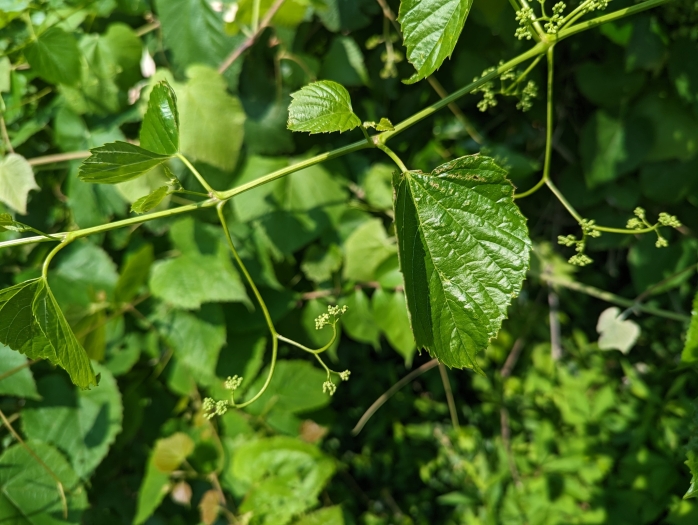Heartleaf Peppervine
(Ampelopsis cordata)
Heartleaf Peppervine (Ampelopsis cordata)
/
/

Ryan Sorrells
CC BY 4.0
Image By:
Ryan Sorrells
Recorded By:
Copyright:
CC BY 4.0
Copyright Notice:
Photo by: Ryan Sorrells | License Type: CC BY 4.0 | License URL: http://creativecommons.org/licenses/by/4.0/ | Rights Holder: Ryan Sorrells | Publisher: iNaturalist | Date Created: 2023-05-20T11:04:21-07:00 |

























Estimated Native Range
Summary
Ampelopsis cordata, commonly known as heartleaf peppervine, is a deciduous vine native to a variety of habitats in the southeastern United States, including open woodlands, floodplains, and river banks. It is found in states such as Alabama, Arkansas, Connecticut, Delaware, Florida, Georgia, Iowa, Illinois, Indiana, Kansas, Kentucky, Louisiana, Maryland, Missouri, Mississippi, North Carolina, Nebraska, Ohio, Oklahoma, South Carolina, Tennessee, Texas, Virginia, and West Virginia. This vine can climb to heights of 10-15 feet (3-4.5 meters) with the aid of tendrils, and it features heart-shaped leaves and small, inconspicuous greenish flowers that bloom in the summer. The flowers give way to attractive purple to black berries that are often used in floral arrangements.
Heartleaf peppervine is valued for its rapid growth and dense foliage, which makes it an excellent choice for covering fences, trellises, or arbors. It is also used for erosion control on slopes. In cultivation, it prefers moist, well-drained soils and can tolerate a range of light conditions from full sun to partial shade. While it is relatively low-maintenance, it may require pruning to control its spread. Gardeners should be aware that Ampelopsis cordata can become invasive outside its native range, so it is important to check local regulations before planting.CC BY-SA 4.0
Heartleaf peppervine is valued for its rapid growth and dense foliage, which makes it an excellent choice for covering fences, trellises, or arbors. It is also used for erosion control on slopes. In cultivation, it prefers moist, well-drained soils and can tolerate a range of light conditions from full sun to partial shade. While it is relatively low-maintenance, it may require pruning to control its spread. Gardeners should be aware that Ampelopsis cordata can become invasive outside its native range, so it is important to check local regulations before planting.CC BY-SA 4.0
Plant Description
- Plant Type: Shrub, Vine
- Height: 12-36 feet
- Width: 3-36 feet
- Growth Rate: Moderate
- Flower Color: Green, White
- Flowering Season: Spring, Summer
- Leaf Retention: Deciduous
Growth Requirements
- Sun: Full Sun, Part Shade
- Water: Medium
- Drainage: Fast, Medium, Slow
Common Uses
Bird Garden
Natural Habitat
Native to a variety of habitats including open woodlands, floodplains, and river banks in the southeastern United States
Other Names
Common Names: Racoon Grape, False Grape, Heart-Leaf Ampelopsis, Raccoon-Grape
Scientific Names: , Ampelopsis cordata, Ampelopsis cordifolia, Cissus ampelopsis, Cissus indivisa, Vitis cordata, Vitis indivisa,
GBIF Accepted Name: